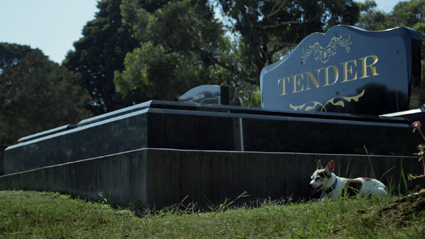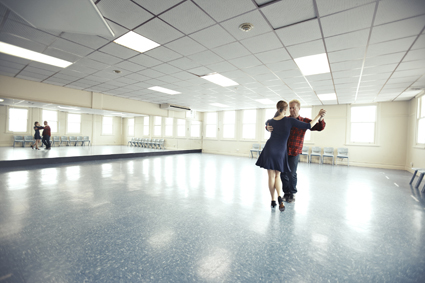Artists as filmmakers
Kath Dooley: The Hive Production Fund Films

Tender, Lynette Wallworth
What happens when you take three of Australia’s most innovative and dynamic artists—media artist Lynette Wallworth, choreographer Gideon Obarzanek and theatre director Michael Kantor—and provide them with $670,000 in funding to produce arts-based films in multidisciplinary teams? The results were on show over three Sunday nights in June when ABC1 screened these three bold projects fostered by the Hive Lab, an initiative of the 2011 Adelaide Film Festival.
With additional funding from ABC Arts and Entertainment, the Australia Council, Screen Australia and the South Australian Film Corporation, these ambitious films were developed in a workshop environment with the aim of “break(ing) down the silos between film and the rest of the arts,” said Katrina Sedgwick (then director of the Adelaide Film Festival and now of ABC Arts and Entertainment) in 2011. The films premiered at the Adelaide Film Festival in October 2013 and have since enjoyed success in other venues. For example, Obarzanek’s I Want to Dance Better at Parties was recently awarded the Dendy Award for Best Live Action Short at the 2014 Sydney Film Festival and Wallworth’s Tender received the $25,000 David and Joan Williams Documentary Fellowship Award at the 2014 Australian International Documentary Conference.
Lynette Wallworth, Tender
Wallworth’s Tender was produced by Kath Shelper, whose previous work includes the award-winning Samson & Delilah (2009, director Warwick Thornton). This touching 73-minute documentary follows the quest of a small but determined community group in Port Kembla (NSW) who aim to set up their own low-cost funeral service. Led by their manager (and Wallworth’s lifelong friend, Jenny Briscoe-Hough), the residents attempt to bypass the commercial drivers of the funeral industry, to make their own coffins and to access their own burial ground. As their plans gain traction, the community centre’s caretaker Neil is diagnosed with terminal cancer and it becomes clear that his funeral will be the group’s first responsibility. This unforeseen twist (Neil received his diagnosis two weeks before filming began and then passed away before the film’s 10-week shoot was over) adds a sense of urgency to the group’s project.
From the outset, this observational ‘fly on the wall’ work gives the audience intimate access to the group’s frank discussions concerning the nature of death and dying. Both the static and handheld cinematography by Simon Morris keeps the viewer close to the participants as they go about their daily business, also capturing expressions of emotion as they grieve for their much-loved friend and colleague. One particularly affecting sequence sees Wallworth utilise still photography to capture images of Neil’s body being prepared for his funeral. Tender is ultimately an insightful and uplifting film, which questions the protocols associated with the act of dying. (See realtime tv interview with Lynette Wallworth.)

Elizabeth Nabben, Steve Rogers, I Want to Dance Better at Parties
photo Ian Routledge
Elizabeth Nabben, Steve Rogers, I Want to Dance Better at Parties
Gideon Obarzanek, I Want to Dance Better at Parties
Gideon Obarzanek’s I Want to Dance Better at Parties is a hybrid project based on the 2004 Chunky Move dance production of the same name. Co-written and directed by Matthew Bate (creator of Shut Up Little Man! An Audio Misadventure, 2011) and produced by his colleague Rebecca Summerton at Adelaide-based Closer Productions, this 28-minute docudrama tells the story of middle-aged Phillip Rose, a single parent recovering from the untimely death of his wife. Seeking to improve his dance style (and by consequence, his social life) Rose takes up weekly dance classes with an enthusiastic young instructor, Melissa (Elizabeth Nabben). In an otherwise deserted dance studio he learns a variety of sensual Latin dances and the two become friends, ultimately performing together in an amateur dance competition. This climatic competition scene recalls that of Strictly Ballroom (Baz Luhrmann, 1992), but is in fact filmed using a real-world backdrop, with competitive dancers and members of the public.
The film is narrated by Rose himself in documentary style, but the story is also dramatically recreated with a sympathetic and somewhat dance-challenged Steve Rogers in the central role. Rose himself occasionally appears in the background of these recreated scenes, as if he’s watching and reliving his lonely experiences from a more comfortable place. A handheld camera follows over Rose’s shoulder or offers his point of view as he dances, fostering strong audience identification. I Want to Dance Better at Parties successfully weaves documentary and drama, film and dance, to create a moving portrayal of a man reclaiming lost meaning in his life.
Michael Kantor, The Boy Castaways
The Boy Castaways is perhaps the most ambitious of the three films. Directed by former Malthouse Theatre director Michael Cantor, this feature length rock musical (touted as a reimagining of Peter Pan) stars Mark Leonard Winter as insomniac office worker Michael, a man drawn into a surreal parallel world that exists in a mysterious theatre. Here he joins a bizarre mix of characters who seem midway through the staging of an elaborate spectacle (Tim Rogers as the cryptic Peter, Marco Chiappi as the demanding George and Paul Capsis as gentle Nico). Michael finds himself drawn to enigmatic theatre manager Sarina (Megan Washington) but he cannot be sure that she returns his affections. As the narrative moves between musical numbers on and off stage, the audience is positioned alongside Michael, wondering what is real and what is artifice.
The bold colour and high contrast lighting of Cantor’s theatrical visuals is a delight for the eye but the camera often frames subjects in distancing wide shots, making it hard to engage with characters on an emotional level. The uttering of cryptic and isolated lines of dialogue turns the film’s first half into something reminiscent of a Mad Hatter’s tea party, with Michael seemingly perplexed as to his place in the performance. The film’s dark ending, which sees death as a means of rebirth, returns the protagonist to the outside world, leaving the viewer with questions concerning the nature of his journey.
It is perhaps coincidental that the three Hive projects explore common themes of death, escape and grieving. Although diverse in their content and methods of realisation, each presents a unique viewing experience, delivering boutique film festival content to public television.
HIVE Production Fund Films: Tender, writer, director Lynette Wallworth, producer Kath Shelper, cinematographer Simon Morris, editor Karryn de Cinque, sound designer Liam Egan, music Nick Cave & Warren Ellis; I Want to Dance Better at Parties, directors, writers Matthew Bate, Gideon Obarzanek, producer: Rebecca Summerton, editor: Bryan Mason, cinematographer Bryan Mason, composer: Benjamin Speed; The Boy Castaways, director Michael Kantor, writers Michael Kantor, Raimondo Cortese, producers: Jo Dyer, Stephen Armstrong, executive Producer: Robert Connolly; ABC1, June
RealTime issue #122 Aug-Sept 2014 pg. 28






